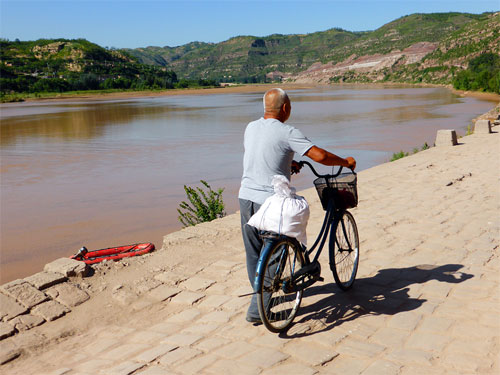Qikou Town 碛口 Shanxi Province山西省
Qikou Yellow River Town
Qikou Yellow River Town is an ancient historic riverine town on the banks of the Yellow River in a remote part of Shanxi Province. Even though Qikou is virtually unknown to western tourists, Chinese domestic tourists are beginning to arrive in ever increasing numbers.

We arrived in Qikou after one of those frustrating and often terrifying China back road trips that make you swear to yourself “never again” but you always return for more. On arrival we were rewarded with grand vistas of the mighty Yellow River and seduced by an enchanting classic Chinese ancient town, as yet not converted into a tourist theme park.
Frustrating and Terrifying Journey to Qikou
It had been a frustrating ride because of a huge, infernal traffic jam, caused by one of the thousands of overloaded coal trucks that ply the Shanxi roads, which had rolled over and blocked the narrow, mountainous and potholed road. Terrifying, because our tiny car, dwarfed by the lurching trucks, kept having to dodge them as they overtook each other on blind corners.
However, as we opened the first of many cold beers on the grand terrace of the Qikou Guesthouse, any nasty lingering memories of the trip were soon dispelled.
Qikou is an ancient port on the Yellow River (see our previous article on The Qikou Inn for more information). Nowadays there is scarcely any river traffic; a few sad, rusting boats tied up along the river bank are all that remains of a once thriving commercial town.
Qikou Yellow River Town is Remote
Qikou is also very isolated; it is almost only accessible via the tortuous mountain road from Lüliang Lishi 吕梁离石 or just Lishi离石. On the other bank of the Yellow River are the barren hills of Shaanxi Province with no other settlement in sight. It is probably this isolation that has preserved Qikou as an authentic old town with few amenities to entertain the domestic tourist hordes.
Changes are coming
However, that will all change in the near future. Many new hotels, admittedly tastefully done up to resemble traditional Inns, have popped up along the main street by the river. A new car park was being built in the town centre, while a huge stage was under construction on the banks of the river a few kilometres out of town, apparently to hold opera performances and other types of entertainment.
Qikou Yellow River Town: How to Enjoy it
For the moment though, you can still enjoy peaceful strolls around the town. Signposts in Chinese and English point out the historical importance of some of the buildings. While some of the old Ming and Qing houses are rather run down, others are being spruced up and restored.
Locals don’t seem to mind you glancing into their attractive courtyards. Many of the houses have back rooms tunneled into the hillside. In fact, this is one of the best areas to explore Shanxi’s cave dwelling architecture.
The windy cobbled streets all head up from the river to one place: The Black Dragon Temple 黑龙庙. The temple is small, simple but attractive and includes an ancient opera stage whose acoustics apparently were so good that the performances could be heard on the other side of the river.
Mostly though, it’s for the sweeping views over the old town and the Yellow River that visitors climb up here.
It’s no wonder the place is frequented by art students practising their painting and drawing skills. At sundown, the Black Dragon Temple is a magical place and the old town of Qikou down below looks picture postcard perfect.
Lijiashan 李家山
Another reason for coming to Qikou Town 碛口 is to visit the mountainous cave village of Lijiashan 李家山, whose ancient dwellings have been entirely built into the surrounding hillsides (see next article).
Even though there are other, newer hotels, the Qikou Guesthouse or Inn (see our previous article The Qikou Inn for more information) must be the most atmospheric one! We paid 188 Yuan for a double with bathroom on the second floor, with its own small sitting area outside. There was no haggling. Also, unfortunately, no towels, though we managed to persuade them to give us a couple of stamp-sized ones.
Food
We ate in the Qikou guesthouse where meals are simple, but very tasty; especially the homemade noodles! Beers were very cold.
Getting there and away
Taiyuan to Qikou. A bus from Taiyuan’s Western Bus Station to Lishi离石, sometimes known as Lüliang Lishi 吕梁离石, cost 48 Yuan and took nearly three hours.
There are frequent buses from Lishi to Qikou, but we negotiated a taxi for 150 Yuan, hoping to save some time… The way there was a nightmare, with dozens of massive coal trucks causing huge traffic jams. It took over two hours to cover the mere 50 kilometers. However, on the return we never saw a single truck and the journey took just an hour. Bizarre!
If you are moving on to Pingyao, there is a bus from Lishi, departing at 13.40.




















One thought on “Qikou Yellow River Town”